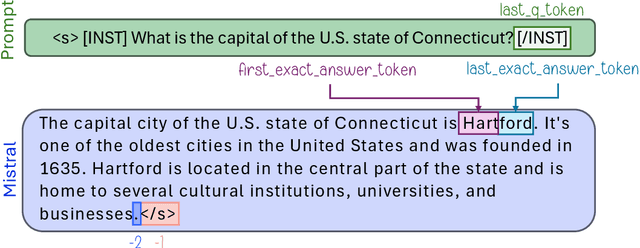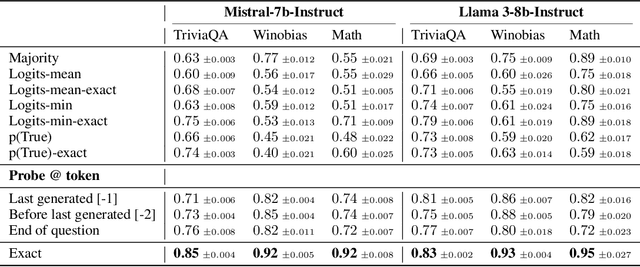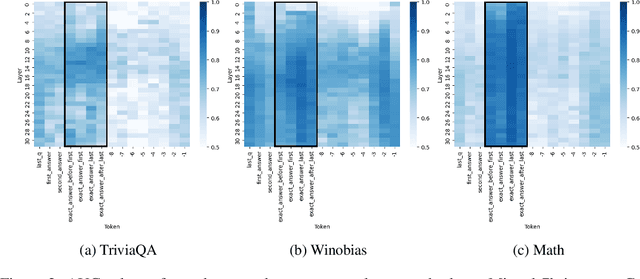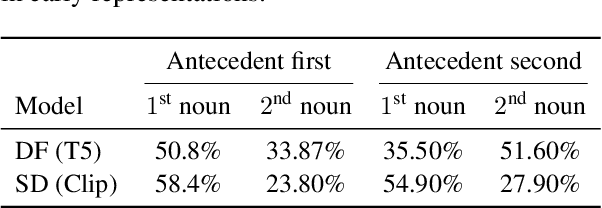Hadas Orgad
MIB: A Mechanistic Interpretability Benchmark
Apr 17, 2025Abstract:How can we know whether new mechanistic interpretability methods achieve real improvements? In pursuit of meaningful and lasting evaluation standards, we propose MIB, a benchmark with two tracks spanning four tasks and five models. MIB favors methods that precisely and concisely recover relevant causal pathways or specific causal variables in neural language models. The circuit localization track compares methods that locate the model components - and connections between them - most important for performing a task (e.g., attribution patching or information flow routes). The causal variable localization track compares methods that featurize a hidden vector, e.g., sparse autoencoders (SAEs) or distributed alignment search (DAS), and locate model features for a causal variable relevant to the task. Using MIB, we find that attribution and mask optimization methods perform best on circuit localization. For causal variable localization, we find that the supervised DAS method performs best, while SAE features are not better than neurons, i.e., standard dimensions of hidden vectors. These findings illustrate that MIB enables meaningful comparisons of methods, and increases our confidence that there has been real progress in the field.
Inside-Out: Hidden Factual Knowledge in LLMs
Mar 19, 2025Abstract:This work presents a framework for assessing whether large language models (LLMs) encode more factual knowledge in their parameters than what they express in their outputs. While a few studies hint at this possibility, none has clearly defined or demonstrated this phenomenon. We first propose a formal definition of knowledge, quantifying it for a given question as the fraction of correct-incorrect answer pairs where the correct one is ranked higher. This gives rise to external and internal knowledge, depending on the information used to score individual answer candidates: either the model's observable token-level probabilities or its intermediate computations. Hidden knowledge arises when internal knowledge exceeds external knowledge. We then present a case study, applying this framework to three popular open-weights LLMs in a closed-book QA setup. Our results indicate that: (1) LLMs consistently encode more factual knowledge internally than what they express externally, with an average gap of 40%. (2) Surprisingly, some knowledge is so deeply hidden that a model can internally know an answer perfectly, yet fail to generate it even once, despite large-scale repeated sampling of 1,000 answers. This reveals fundamental limitations in the generation capabilities of LLMs, which (3) puts a practical constraint on scaling test-time compute via repeated answer sampling in closed-book QA: significant performance improvements remain inaccessible because some answers are practically never sampled, yet if they were, we would be guaranteed to rank them first.
Position-aware Automatic Circuit Discovery
Feb 07, 2025Abstract:A widely used strategy to discover and understand language model mechanisms is circuit analysis. A circuit is a minimal subgraph of a model's computation graph that executes a specific task. We identify a gap in existing circuit discovery methods: they assume circuits are position-invariant, treating model components as equally relevant across input positions. This limits their ability to capture cross-positional interactions or mechanisms that vary across positions. To address this gap, we propose two improvements to incorporate positionality into circuits, even on tasks containing variable-length examples. First, we extend edge attribution patching, a gradient-based method for circuit discovery, to differentiate between token positions. Second, we introduce the concept of a dataset schema, which defines token spans with similar semantics across examples, enabling position-aware circuit discovery in datasets with variable length examples. We additionally develop an automated pipeline for schema generation and application using large language models. Our approach enables fully automated discovery of position-sensitive circuits, yielding better trade-offs between circuit size and faithfulness compared to prior work.
Padding Tone: A Mechanistic Analysis of Padding Tokens in T2I Models
Jan 12, 2025



Abstract:Text-to-image (T2I) diffusion models rely on encoded prompts to guide the image generation process. Typically, these prompts are extended to a fixed length by adding padding tokens before text encoding. Despite being a default practice, the influence of padding tokens on the image generation process has not been investigated. In this work, we conduct the first in-depth analysis of the role padding tokens play in T2I models. We develop two causal techniques to analyze how information is encoded in the representation of tokens across different components of the T2I pipeline. Using these techniques, we investigate when and how padding tokens impact the image generation process. Our findings reveal three distinct scenarios: padding tokens may affect the model's output during text encoding, during the diffusion process, or be effectively ignored. Moreover, we identify key relationships between these scenarios and the model's architecture (cross or self-attention) and its training process (frozen or trained text encoder). These insights contribute to a deeper understanding of the mechanisms of padding tokens, potentially informing future model design and training practices in T2I systems.
LLMs Know More Than They Show: On the Intrinsic Representation of LLM Hallucinations
Oct 03, 2024



Abstract:Large language models (LLMs) often produce errors, including factual inaccuracies, biases, and reasoning failures, collectively referred to as "hallucinations". Recent studies have demonstrated that LLMs' internal states encode information regarding the truthfulness of their outputs, and that this information can be utilized to detect errors. In this work, we show that the internal representations of LLMs encode much more information about truthfulness than previously recognized. We first discover that the truthfulness information is concentrated in specific tokens, and leveraging this property significantly enhances error detection performance. Yet, we show that such error detectors fail to generalize across datasets, implying that -- contrary to prior claims -- truthfulness encoding is not universal but rather multifaceted. Next, we show that internal representations can also be used for predicting the types of errors the model is likely to make, facilitating the development of tailored mitigation strategies. Lastly, we reveal a discrepancy between LLMs' internal encoding and external behavior: they may encode the correct answer, yet consistently generate an incorrect one. Taken together, these insights deepen our understanding of LLM errors from the model's internal perspective, which can guide future research on enhancing error analysis and mitigation.
Diffusion Lens: Interpreting Text Encoders in Text-to-Image Pipelines
Mar 09, 2024



Abstract:Text-to-image diffusion models (T2I) use a latent representation of a text prompt to guide the image generation process. However, the process by which the encoder produces the text representation is unknown. We propose the Diffusion Lens, a method for analyzing the text encoder of T2I models by generating images from its intermediate representations. Using the Diffusion Lens, we perform an extensive analysis of two recent T2I models. Exploring compound prompts, we find that complex scenes describing multiple objects are composed progressively and more slowly compared to simple scenes; Exploring knowledge retrieval, we find that representation of uncommon concepts requires further computation compared to common concepts, and that knowledge retrieval is gradual across layers. Overall, our findings provide valuable insights into the text encoder component in T2I pipelines.
Unified Concept Editing in Diffusion Models
Aug 25, 2023



Abstract:Text-to-image models suffer from various safety issues that may limit their suitability for deployment. Previous methods have separately addressed individual issues of bias, copyright, and offensive content in text-to-image models. However, in the real world, all of these issues appear simultaneously in the same model. We present a method that tackles all issues with a single approach. Our method, Unified Concept Editing (UCE), edits the model without training using a closed-form solution, and scales seamlessly to concurrent edits on text-conditional diffusion models. We demonstrate scalable simultaneous debiasing, style erasure, and content moderation by editing text-to-image projections, and we present extensive experiments demonstrating improved efficacy and scalability over prior work. Our code is available at https://unified.baulab.info
ReFACT: Updating Text-to-Image Models by Editing the Text Encoder
Jun 01, 2023Abstract:Text-to-image models are trained on extensive amounts of data, leading them to implicitly encode factual knowledge within their parameters. While some facts are useful, others may be incorrect or become outdated (e.g., the current President of the United States). We introduce ReFACT, a novel approach for editing factual knowledge in text-to-image generative models. ReFACT updates the weights of a specific layer in the text encoder, only modifying a tiny portion of the model's parameters, and leaving the rest of the model unaffected. We empirically evaluate ReFACT on an existing benchmark, alongside RoAD, a newly curated dataset. ReFACT achieves superior performance in terms of generalization to related concepts while preserving unrelated concepts. Furthermore, ReFACT maintains image generation quality, making it a valuable tool for updating and correcting factual information in text-to-image models.
Editing Implicit Assumptions in Text-to-Image Diffusion Models
Mar 14, 2023Abstract:Text-to-image diffusion models often make implicit assumptions about the world when generating images. While some assumptions are useful (e.g., the sky is blue), they can also be outdated, incorrect, or reflective of social biases present in the training data. Thus, there is a need to control these assumptions without requiring explicit user input or costly re-training. In this work, we aim to edit a given implicit assumption in a pre-trained diffusion model. Our Text-to-Image Model Editing method, TIME for short, receives a pair of inputs: a "source" under-specified prompt for which the model makes an implicit assumption (e.g., "a pack of roses"), and a "destination" prompt that describes the same setting, but with a specified desired attribute (e.g., "a pack of blue roses"). TIME then updates the model's cross-attention layers, as these layers assign visual meaning to textual tokens. We edit the projection matrices in these layers such that the source prompt is projected close to the destination prompt. Our method is highly efficient, as it modifies a mere 2.2% of the model's parameters in under one second. To evaluate model editing approaches, we introduce TIMED (TIME Dataset), containing 147 source and destination prompt pairs from various domains. Our experiments (using Stable Diffusion) show that TIME is successful in model editing, generalizes well for related prompts unseen during editing, and imposes minimal effect on unrelated generations.
Debiasing NLP Models Without Demographic Information
Dec 20, 2022Abstract:Models trained from real-world data tend to imitate and amplify social biases. Although there are many methods suggested to mitigate biases, they require a preliminary information on the types of biases that should be mitigated (e.g., gender or racial bias) and the social groups associated with each data sample. In this work, we propose a debiasing method that operates without any prior knowledge of the demographics in the dataset, detecting biased examples based on an auxiliary model that predicts the main model's success and down-weights them during the training process. Results on racial and gender bias demonstrate that it is possible to mitigate social biases without having to use a costly demographic annotation process.
 Add to Chrome
Add to Chrome Add to Firefox
Add to Firefox Add to Edge
Add to Edge